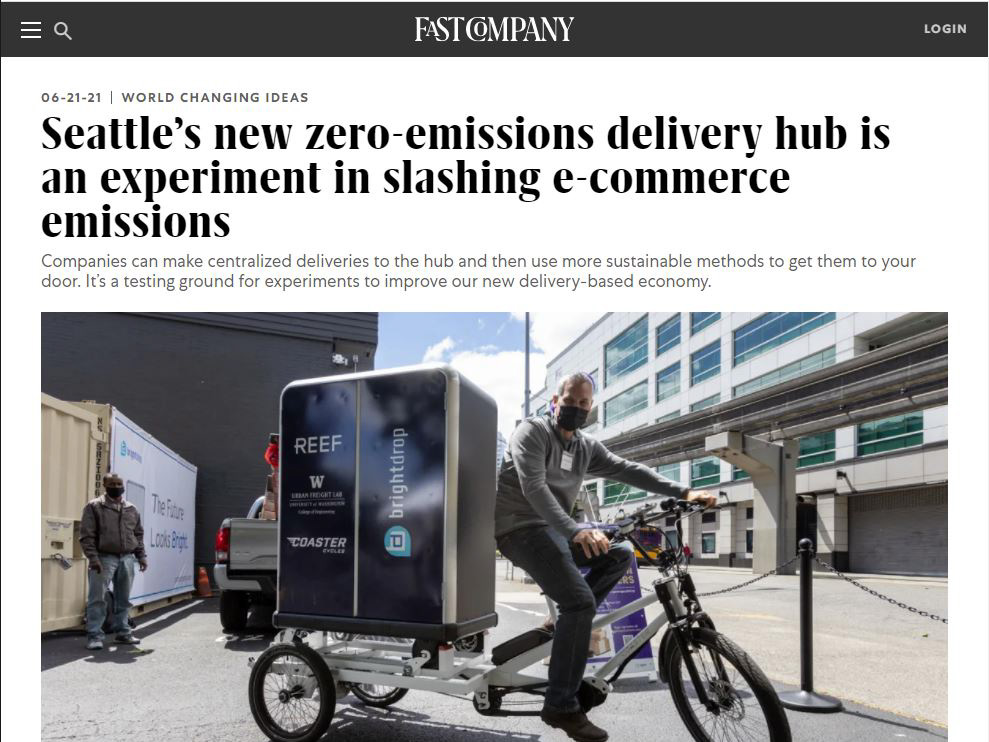
By Talib Visram
As companies and governments strategize to make our exploding e-commerce economy more environmentally friendly, the “last mile” of a product’s journey—that is, the very last stage, from the transportation hub to the customer, currently appears the easiest to target. That’s especially true in cities, where higher population densities and shorter distances allow for the use of electric vehicles and micro-mobility options for getting packages into consumers’ hands.
Seattle is exploring that potential, launching a testing ground for a variety of logistics strategies to try and achieve zero emissions in the last-mile portion of delivery. Congregating various partners, it’s designed a “microhub” that will be home to cargo bikes, electric vehicles and pallets, and food trucks. It’s one of the first pilots in the country of its kind to drive a shift to a “neighborhood-scale delivery model,” as the nature of retail changes. With the city’s department of transportation also on board, it will align with Seattle’s climate goals of reaching carbon neutrality by 2050.
It’s best defined as a “research enterprise . . . for people to come in and test, revise, refine, and improve their delivery models,” says Anne Goodchild, founding director of the Supply Chain Transportation and Logistics Center at the University of Washington, whose Urban Freight Lab is coordinating the project. “We’re in this transition period where there’s some pretty imperfect things that we see happening,” she says, such as multiple carbon-emitting vans making multiple deliveries within the same neighborhoods. Still, buyers want to shop online, and there’s an opportunity for cities to use land differently as brick-and-mortar stores fade out. “We could have a delivery system that is compatible with the way we want our communities to look, and feel, and sound, and run.”
Due to its mix of commercial and residential units, the Belltown neighborhood was chosen to house the microhub, a former parking lot about the size of a quarter block, which is basically a central site for packages. The first delivery company to participate is logistics business AxleHire, which currently dispatches items for companies including HelloFresh and Blue Apron. “This new kind of zero-emission mobility options are the future of urban delivery,” says Daniel Sokolovsky, AxleHire’s founder and president. Vans drop off all the packages headed for the neighborhood to the hub—cutting out the need for multiple trips to residences and businesses—and from there, they’ll make their way to customers in other, more sustainable ways.
That may be via electric vehicles, which are becoming a bigger part of AxleHire’s drivers’ fleet. Some deliveries may take place by foot, and a big portion will be by cargo bikes, provided by another partner, Coaster Cycles, a fleet of electric-assisted bikes. They’ll be assisted by yet another partner: General Motors’ BrightDrop, designers of an electric pallet. Christened the EP1, the pallet has innovated the old-fashioned dolly, which has seen little change in decades, and the Coaster Cycles are designed to carry them.
They have four wheels, are easier to navigate around corners, and mean less physical exertion for delivery drivers. “[A driver] can have 100 or 1,000 pounds inside of there,” Sokolovsky says, “and they’re using the exact same amount of effort to actually move that pallet.” There will also be parcel lockers on site, so people can collect their packages in person if they want. The concept is similar to Amazon lockers, but shared between couriers, as Goodchild hopes to onboard more as the pilot progresses; she says they are in ongoing conversations with FedEx and UPS.
Another element of the pilot is “ghost kitchens,” a collection of on-site food trucks without the serving windows, provided by partner Reef, whose employees will cook food at the hub for restaurants around the city. Customers will simply order meals as normal via their food delivery services, like Uber Eats or Postmates, and then drivers will deliver them from the hub kitchens. So far, one eatery has signed on, Man vs Fries.
Some of those deliveries may not be zero-emissions, but the idea is that sustainability will constantly improve as the pilot progresses. There’s no end date; the idea is for the hub to welcome more and more partners and experiments—like, perhaps, robot deliveries—to continually increase carbon efficiency and urban friendliness. Inbound vans, bringing boxes to the hub, may soon also become more environmentally efficient as larger vehicles move toward electrification. “Give it a year, give it two more years, and that would be easy enough, too,” Sokolovsky says. Because AxleHire uses its own software, it will provide much of the data for evaluating the pilot’s effectiveness.
Goodchild doesn’t intend the model to scale around the country in the same exact form, but rather hopes it acts as an example of what could be possible for urban communities. Santa Monica launched a similar project in February. The solution for each neighborhood, Goodchild imagines, will look different. “When I foresee the future of microhubs, they’re publicly accessible neighborhood assets,” she says. In the future, some may contain facilities for drivers, scooter charging stations—even “pocket parks” and picnic tables on which to eat the food from the kitchens. “I invite people to imagine what other cool things they could have there.”